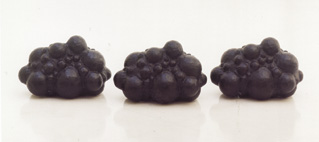Before, there were large rubber shawls. Flávia Ribeiro’s shawls were
like flat, oblong beings, huge smooth pelts that seemed to have
sensitive qualities. Given the nature of the material, they fell in an
almost uniform manner, but allowed varying undulations that were vaguely
reminiscent of sculptured drapery: a sweet, serene Bernini mobile, with
no baroque effusion. A few, subdued shapes in relief on the surface of
the rubber called for a closer look. When the observer drew back, he
noticed the slight tremor caused by the breeze blowing through the room.
In this process, he was captivated by those silent upright lakes that
had seemed to make up a desert landscape before the reliefs caught his
eye.
One could dream of being covered by the landscape of Flávia
Ribeiro’s shawls. However, prior to any flight of fancy, what was at
issue here was a limit-experience in sculpture, taking place on the
borders of ostensive planes countered by movements and undulations. In
these sculptures the material functioned not only as a plastic element
but also by substantivizing issues - delicacy, flexibility, lightness,
everything - as the materialization into pure visibility of an existence
governed against the rigid world of dogma.
Now the sculptures are cast in metal, some given a dark patina, others
gilded. The change of material is striking. Nonetheless, something of
the earlier organic universe has been preserved: the manipulation of
molds has left marks on the irregular surface of the spheres. The artist
does not aspire to the anonymous perfection of machines or the utopia of
ideal forms; her goal is to create entities marked by the passage of
being that has elevated them to the condition of works of art. And these
marks could never have been contained in the calculations of a project.
They are the product of the empirical struggle of trial and error, and
they show plainly, in their finished form, the experience that gave rise
to them. Each element shows this process, which is potentiated when the
works are articulated with one another.
|
-
The large
sphere, throwing out a long, tense, rigid tentacle to the wall,
reconfigures space in its entirety. Its presence is not contained in the
limits of its body. It radiates its plastic force all around, and acts
as a kind of inductor of perception of the other pieces. Its monumental
scale does not have the effect of dwarfing the smaller works; instead,
it underscores their virtual possibilities. Indeed, this seems to be one
of the most striking characteristics of these new works by Flávia
Ribeiro: their ability to claim virtual monumentality, whatever their
actual size - a trait that could only be the outcome of intelligent
formal solutions.
This is not an exclusive trait of the pieces seen in isolation. Placed
together, as in the series of triple spheres joined by two arms, we can
also imagine them in solitary existence, a powerful presence in the
corner of a room, or as a crowd of sculptures that multiply themselves,
covering a wide expanse of outdoor space. In this complex of articulated
sculptures there is a strong manifestation of collective existence that
entails no loss of the characteristics of each individual. That is why
they are not modules that are joined as parts to make up a whole: each
element has an autonomous reality of its own.
By its very nature, the shape of the sphere suggests movement. The ball
demands to roll or fly, on a soccer field, on a tennis court, on a
billiard table or even in cosmic space. A sphere at rest seems to be in
expectation of the force that will move it from one state of inertia to
another.
Flávia Ribeiro’s spheres, given a shape that makes it impossible for
them to roll, are endowed with a different sort of movement: the
wandering movement of the transitive eye from one sphere to another,
which they elicit through their articulations and their irregular
surfaces. There is no rest in these seemingly motionless sculptures. The
serene spheres, grouped in opposing pairs on the table, or the smaller,
crinkly, frisky pieces, the net of triple sculptures on the floor, or
the large sphere with its spear - all of them demand an eye that can
follow the movement of form.
Flávia Ribeiro’s personal discretion, together with her inquisitiveness
that avoids ostentation, stands out, in a milieu dominated by show-offs,
for the depth of her contribution to contemporary art. The present show
testifies to this.
Paulo Sergio
Duarte
|

